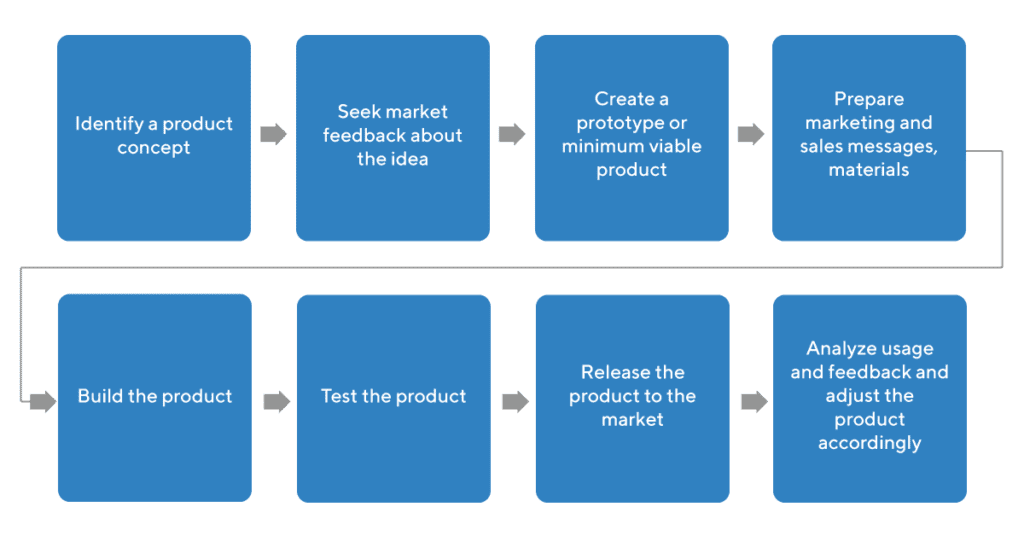Product development describes the entire process of bringing a product to the market. The process can include identifying a product concept, seeking market feedback about the idea, creating a prototype, preparing marketing and sales campaigns, building the product and releasing it to customers, and making adjustments based on market feedback.

How to Create a Product Development Strategy
The product management team plays a crucial role in product development—acting as the strategic directors of the process. But although we use the two terms often interchangeably, product development is not synonymous with product management. Product development is a much broader process that involves the coordinated effort of many teams across a company, including:
- Product management
- Design (UX/UI)
- Development (or manufacturing)
- Marketing
- Testing and QA
- Sales
- Shipping or distribution
- Support
What is a Product Development Strategy?
To achieve market success with its product, an organization must first map out a methodology. It should be a step-by-step plan that will allow the team to move the product forward at each stage along its journey from concept to market launch.
We call this predefined process and sequence of events the product development strategy.
A product development strategy is crucial for several reasons. Here are just a few.
1. It helps align the cross-functional team around the big-picture goals and priorities from the start.
This will help the team make better-informed tactical decisions throughout the development process when challenges and questions arise—which they always do during product development.
2. It provides the team with feedback and guidance for every step of the product’s development journey.
Imagine that during the market-validation stage of its new concept, the product team finds lower-than-expected levels of interest from its user personas.
If the team is operating from a predefined product development strategy they will be in a better position to know whether to proceed with their original plan or to pivot and prioritize other functionality first.
3. It enables more efficient development.
When a company has a clearly defined product development strategy, there will be a better sense of how to allocate resources and estimate timeframes throughout the development cycle.
In an agile development organization, this will also help clarify which task-level initiatives take priority at any given time, and which ones to include in an upcoming sprint.
Build a Product Development Strategy Around Design Thinking
Product development strategies differ by company, industry, and other factors. There is no one-size-fits-all approach that works under all circumstances. There are common elements to many successful product development strategies.
Let’s discuss how a company could build a product development strategy around the design thinking approach—a framework for creating products based on looking at the world from your user’s perspective.
The Design Thinking Approach:
- Empathize with users
- Define the problem
- Brainstorm potential solutions
- Build a prototype
- Test your solution
Applying a Product Development Strategy to The Design Thinking Approach:
Step 1: Empathize with users.
Home appliance manufacturers devised a simple strategy decades ago to see the world through the eyes of their users. The product managers for these companies would visit the homes of customers and ask to watch as they used their products—dishwashers, vacuum cleaners, blenders, etc.
The PMs would take note of which features customers used, how they activated those features (which often wasn’t the way the company intended), what problems they encountered while using the products, and what if any workarounds they came up with.
For example, let’s say a customer is dealing with a vacuum cleaner with a long cord that tangled easily. The customer might simply throw the cord over her shoulder while vacuuming. It signaled to the product team that they needed a better solution to help users keep the cord out of the way while they vacuumed.
You might not be able to visit your customers’ homes, but what strategies can you devise to gain a sense of how your user persona views the world. And, how can your products solve their real-world challenges?
Step 2: Define the problem
Now that you’ve been able to view how your users view the world, you can think through some of the challenges they face. Where have you noticed them throwing a vacuum-cleaner cord over their shoulders?
For every step in your product development strategy, you will want to create a structure, a plan.
You might organize your work into the following 3 steps:
1. Write down every user pain point you’ve identified.
2. Distill these into a shortlist, just a handful of pain points. You can narrow the list to only the most severe pain points you’ve found, or according to pain points that you believe your team could most quickly and easily develop a solution. Or a combination of both.
3. Run the list by your product team for additional input, and to arrive at a list the team agrees is worth pursuing.
Step 3: Brainstorm potential solutions
Again, in a product development strategy, you’ll need structure at every step. Brainstorming does not mean simply sitting in a room alone, thinking of ideas. Build a process around it. For example:
1. Pull together your cross-functional team for an open brainstorming session. Before this meeting, you’ll also want to share with the team your findings from whatever research you did to gain more empathy from your users’ point of view. It will help the team better understand the types of solutions you’re hoping to build, and why.
2. Establish go/no-go criteria for each suggestion at the beginning of your session. You might decide, for example, that each person who presents a product idea has 5 minutes to persuade the group that it’s viable. Then, if a majority of the team agrees, the idea advances to the next level.
3. After you’ve narrowed your list of product concepts down to a manageable number, conduct a rough calculation of time, budget, and resources needed to develop a minimum viable product or even a minimum viable feature. Now you have another set of criteria to help you narrow your choice of which product concepts to pursue.
Step 4: Build a prototype
Here you will coordinate with your designers and your development team to build an MVP or a working version of your concept that you can put in real users’ hands to gauge their level of interest.
At this stage, you will have a broad idea of the market problem you’re addressing and your product’s big-picture strategy for solving it. Share this idea with your designers and developers. Let them apply that strategic understanding of their work.
Step 5: Test your solution
In the design thinking approach, this final stage refers not to internal QA testing but to allowing your user personas to try your product and tell you what they like and don’t like about it.
And because this is part of your step-by-step product development strategy, you will want to apply structure to this stage of your product’s journey. You might, for example, want to establish your go/no-go metrics upfront. Will you consider this concept viable if 30% of users say they were impressed with your MVP? If 10% say they’d buy it? Would these numbers need to be higher?
Note: The hypothetical above applies an example of a product development strategy to a specific approach for creating products. But the design thinking approach is only one of many ways that product teams can go about coming up with product ideas worth pursuing. In those other approaches—the New Product Development (NPD) framework is one example—the individual steps in your product development strategy would look different.
An Agile Product Development Strategy
The basic concepts of a product development strategy should remain constant in any type of organization. That means creating a step-by-step approach to development, keeping everyone aligned around the overall strategy. But agile companies approach development differently, and this will affect some of the details of how they plan and execute their product development strategy.
The main difference will be in how quickly the team iterates its product based on market feedback. In a traditional organization, the product team will spend more time and build a complete product before putting it into users’ hands and analyzing their feedback.
In an agile development organization, by contrast, the team will build the minimum functional solution they can and release it to users as quickly as they can. It is where we get the concept of a minimum viable product.
The agile approach can make for a better product development strategy. It allows the product team to spend more time gathering and analyzing real-world feedback—because it’s putting the product into users’ hands closer to the beginning of the process. This process means every subsequent stage of development can benefit from analyzing actual product usage or from hearing users’ thoughts and feelings about the product.

Product Development Strategy for Existing Products
To this point, we’ve discussed product development strategies only in terms of creating a new product. But product teams can and should apply this step-by-step framework to a wide range of other strategic plans. Use a product development strategy for:
- Creating a new product
- Updating an existing product
- Enhancing or repositioning an existing product to enter a new market
- Extending an existing product to including new pricing models or tiers
- Reducing and eventually eliminating product updates and support as it declines
- Sunsetting a product at the end of its lifecycle





